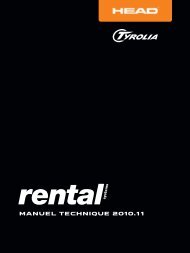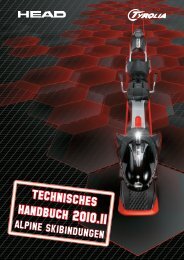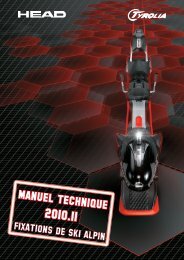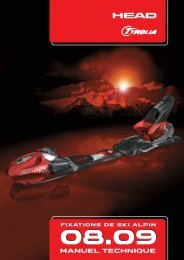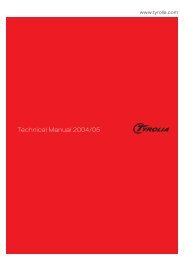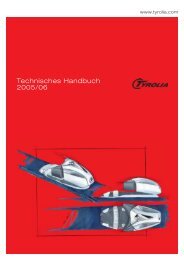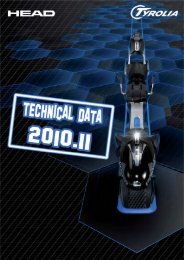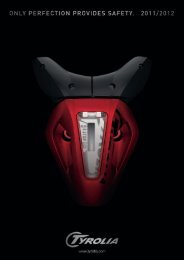Create successful ePaper yourself
Turn your PDF publications into a flip-book with our unique Google optimized e-Paper software.
direction of release is outside of the Inspection<br />
Range provided in Table [A] for Skier Code<br />
used to set up the Reference Binding<br />
(L, J, or F).<br />
9. Repeat the Visual check on all boots that have<br />
been set aside, correct any defects noted,<br />
and retest. Remove from inventory boots that<br />
fail the retest.<br />
10. Check all other boots from the same cell<br />
(make, model. year, and shell size) as those<br />
that failed.<br />
Note: On completion of the preseason inspection,<br />
clean the liquid detergent from equipment and<br />
lubricate the binding before returning it to service.<br />
In season Sampling and<br />
Inspection<br />
The In season Inspection is a test of complete<br />
systems and all the procedures used by the rental<br />
staff to assemble and adjust the system.<br />
The program uses random samples of rental inventory<br />
taken at routine intervals. Any sampling<br />
program that gives every unit of inventory the<br />
same chance as every other of being picked is<br />
valid.<br />
Sample Frequency<br />
Random sampling is conducted throughout the<br />
entire season. Frequency is as follows:<br />
1. After 7 days of operation.<br />
2. If the sample passes the next sampling is<br />
taken after another 7 days operation.<br />
3. If two consecutive samples pass, sampling<br />
frequency is increased to 14 days.<br />
4. If a sample fails at any time, daily sampling is<br />
instituted until two consecutive samples pass,<br />
at which point weekly sampling resumes.<br />
Sample Size<br />
Sample size is 5% of inventory but not less than<br />
16 nor more than 80 units as noted in Table [B].<br />
Sample size is based on average daily output. If<br />
rental output drops below 50% of capacity over<br />
the sampling period, the sample size can reduced<br />
proportionately.<br />
Table [B] Sample Size<br />
In season Inspection<br />
RENTAL / 51<br />
1. Take a random sample of the rental inventory<br />
as determined by Table [B]. Take half the<br />
sample from inventory as it is either rented or<br />
returned and the remainder from inventory<br />
available for rental.<br />
2. The returned samples are tested with the last<br />
customer’s data, the other samples adjust to<br />
randomly selected skier data.<br />
Consider already applied Correction Factors.<br />
3. Wipe the boot clean and cycle the boot/<br />
binding systems at least once in each direction.<br />
4. Test sample units in Twist (one direction only)<br />
and Forward Lean.<br />
5. Compare the Test Results with the Inspection<br />
Range for the appropriate Skier Code, see<br />
ISO 11088 Release/ Retention Adjustment<br />
Chart (page 70).<br />
6. If the results are within the Inspection Range,<br />
one value above to one value below the<br />
reference value, the unit passes.<br />
7. If the results are outside Inspection Range but<br />
within the In-Use Range, two values above to<br />
two values below the reference value, count<br />
the unit as a Class I Deviation.<br />
8. If the results are outside the In-Use Range,<br />
count the unit as a Class II Deviation.<br />
9. Check elastic travel and visually inspect the<br />
ski brake function, interface areas between<br />
boot and binding, including AFD, lug height<br />
adjustment (if appropriate), and forward<br />
pressure. Count any deficiencies as Class I<br />
Deviations.<br />
10. If more than the maximum number of Class I<br />
Deviations given in Table [B] are found in the<br />
sample, or a single Class II Deviation is detected<br />
the sample fails and daily sampling must<br />
be conducted until the problem which led to<br />
the failed sample is found and corrected.<br />
See page 60/61 for Troubleshooting Procedures<br />
following a Failed In season Inspection.<br />
11. Record the date the sample was tested, the<br />
number of units tested the number of Class I<br />
and Class II Deviations, whether the sample<br />
passed or failed and any actions taken.<br />
There is not need to record the identity of units<br />
tested or actual Test Results.<br />
Min. Max<br />
Inventory Size Pairs 100 300 400 500 600 700 800 1600 1700<br />
Sample Size Pairs 16 16 20 25 30 35 40 80 80<br />
Max. Class 1 Dev. 3 3 4 5 6 7 8 16 16



